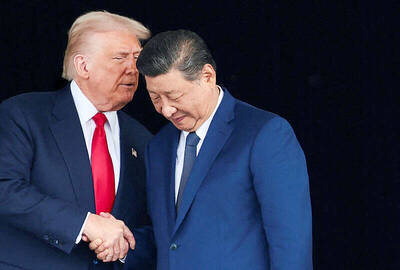A US destroyer and a Canadian frigate conducted a “routine” transit of the Taiwan Strait on Wednesday — their second joint passage in two months — to demonstrate a commitment “to a free and open Indo-Pacific,” the 7th Fleet of the US Pacific Command said yesterday.
In a statement, the US 7th Fleet said that the “unremarkable [and] unprovocative” transit by the USS Rafael Peralta, an Arleigh Burke-class guided-missile destroyer, and the Royal Canadian Navy’s Halifax-class frigate the HMCS Ottawa was made “through waters where high seas freedoms of navigation and overflight apply in accordance with international law.”
The transit was made through “a corridor in the Strait that is beyond the territorial sea of any coastal state” to “demonstrate the commitment of the United States and our allies and partners to a free and open Indo-Pacific,” the US 7th Fleet said.

Photo from the HMCS Ottawa’s Facebook page
“Cooperation like this represents the centerpiece of our approach to a secure and prosperous region where aircraft and ships of all nations may fly, sail and operate anywhere international law allows,” it said.
The Ministry of National Defense later confirmed the transit, saying in a statement that the military was on top of the situation as one US destroyer and one Canadian frigate sailed northward in the Taiwan Strait, and it did not see any irregularities.
China yesterday said its troops were “on constant high alert” after the transit.
“Troops in the theater remain on constant high alert, and will resolutely protect national sovereignty and security as well as regional peace and stability,” Senior Colonel Shi Yi (施毅), a spokesman for China’s Eastern Theater Command, said in a statement.
Shi slammed the latest transit as “public hype” and said its naval and air forces had “trailed their entire course.”
US warships have been making routine, almost monthly passages through the Taiwan Strait for more than two years, occasionally accompanied by vessels from allied nations such as Canada.
The last voyage made by US and Canadian warships was on Sept. 9 by the Arleigh Burke-class guided-missile destroyer USS Ralph Johnson and the Royal Canadian Navy Halifax-class frigate HMCS Ottawa.
Taipei has welcomed such transits, describing them as beneficial to promoting regional peace and stability.
Additional reporting by AFP

Taiwan’s exports soared to an all-time high of US$61.8 billion last month, surging 49.7 percent from a year earlier, as the global frenzy for artificial intelligence (AI) applications and new consumer electronics powered shipments of high-tech goods, the Ministry of Finance said yesterday. It was the first time exports had exceeded the US$60 billion mark, fueled by the global boom in AI development that has significantly boosted Taiwanese companies across the international supply chain, Department of Statistics Director-General Beatrice Tsai (蔡美娜) told a media briefing. “There is a consensus among major AI players that the upcycle is still in its early stage,”

‘SECRETS’: While saying China would not attack during his presidency, Donald Trump declined to say how Washington would respond if Beijing were to take military action US President Donald Trump said that China would not take military action against Taiwan while he is president, as the Chinese leaders “know the consequences.” Trump made the statement during an interview on CBS’ 60 Minutes program that aired on Sunday, a few days after his meeting with Chinese President Xi Jinping (習近平) in South Korea. “He [Xi] has openly said, and his people have openly said at meetings, ‘we would never do anything while President Trump is president,’ because they know the consequences,” Trump said in the interview. However, he repeatedly declined to say exactly how Washington would respond in

Japanese Prime Minister Sanae Takaichi said yesterday that China using armed force against Taiwan could constitute a "survival-threatening situation" for Japan, allowing the country to mobilize the Japanese armed forces under its security laws. Takaichi made the remarks during a parliamentary session yesterday while responding to a question about whether a "Taiwan contingency" involving a Chinese naval blockade would qualify as a "survival-threatening situation" for Japan, according to a report by Japan’s Asahi Shimbun. "If warships are used and other armed actions are involved, I believe this could constitute a survival- threatening

The Central Weather Administration (CWA) yesterday said it expected to issue a sea warning for Typhoon Fung-Wong tomorrow, which it said would possibly make landfall near central Taiwan. As of 2am yesterday, Fung-Wong was about 1,760km southeast of Oluanpi (鵝鑾鼻), Taiwan’s southernmost point, moving west-northwest at 26kph. It is forecast to reach Luzon in the northern Philippines by tomorrow, the CWA said. After entering the South China Sea, Typhoon Fung-Wong is likely to turn northward toward Taiwan, CWA forecaster Chang Chun-yao (張峻堯) said, adding that it would likely make landfall near central Taiwan. The CWA expects to issue a land